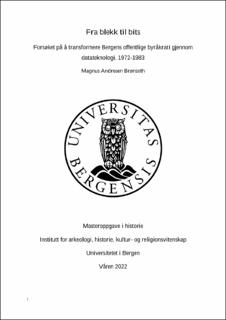| dc.contributor.author | Brønseth, Magnus Andresen | |
| dc.date.accessioned | 2022-06-13T23:37:19Z | |
| dc.date.available | 2022-06-13T23:37:19Z | |
| dc.date.issued | 2022-05-20 | |
| dc.date.submitted | 2022-06-13T22:00:10Z | |
| dc.identifier.uri | https://hdl.handle.net/11250/2998587 | |
| dc.description.abstract | This thesis discusses how and why computer technology was introduced in the municipal government in Bergen between 1972 to1983 and how this led to a transformation within bureaucracy itself. The study’s analytical framework is based around sociotechnical arrangements and analyses changes in the technological and social conditions within the municipal government in Bergen. The study analyses how bureaucratic activity operates, and changes depending on the arrangement in question. In 1972 an EDP/computer-department was established in Bergen municipality. The department began a process of digitization and computerization of public administrative information systems. My thesis shows that between 1972-1983 this integration of computer technology happened within two distinctly different arrangements. Between 1972-1977 the arrangement was characterized by highly centralized structures, and technocratic governance. After 1977 and towards 1983, this arrangement changed in favour of decentralized structures focused on user-participation and network-based technology. The alteration within arrangement also led to new challenges in the formation of digital literacy within the administration. This shift in arrangement stemmed from the technological transformations within the municipal bureaucracy itself and legislative changes on the national level regarding themes like privacy and working environment that altered how the integration of computer technology happened. The reasoning behind the introduction of computer technology was split between two sides. Firstly, the EDP/computer department’s reasoning was based around larger societal effects technology would generally have in the future, and a view of where the technological developments within the computer-sector were already on their way. Secondly, the EDP-department outlined a future view of bureaucracy where digitized information systems would lead to a further effective and rationalized bureaucracy where digitized information systems and computer technology would increase the means of control in different areas of governance. It was this view that they used to argue for further endeavours to digitize and integrate computer technology into bureaucracy. Between 1972-1983 this integration led to different transformations within public bureaucracy. Computerized workspaces led to a new medium of administrative work and information systems were increasingly digitized. By using computer technology, the municipal bureaucracy also saw the introduction of a new form of expertise focused on the use of information technology within public governance. | |
| dc.language.iso | nob | |
| dc.publisher | The University of Bergen | |
| dc.rights | Copyright the Author. All rights reserved | |
| dc.title | Fra blekk til bits: forsøket på å transformere Bergens offentlige byråkrati gjennom datateknologi, 1972-1983 | |
| dc.title.alternative | From Ink to Bit: The Endeavour to Transform Bergen Municipal Administration Through Computer Technology | |
| dc.type | Master thesis | |
| dc.date.updated | 2022-06-13T22:00:10Z | |
| dc.rights.holder | Copyright the Author. All rights reserved | |
| dc.description.degree | Historie mastergradsoppgave | |
| dc.description.localcode | HIS350 | |
| dc.description.localcode | MAHF-LÆHR | |
| dc.description.localcode | MAHF-HIS | |
| dc.subject.nus | 713107 | |
| fs.subjectcode | HIS350 | |
| fs.unitcode | 11-22-0 | |
